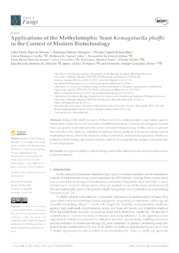Applications of the methylotrophic yeast komagataella phaffii in the context of modern biotechnology.
Applications of the methylotrophic yeast komagataella phaffii in the context of modern biotechnology.
Author(s): MORAES, L. M. P. de; MARQUES, H. F.; REIS, V. C. B.; COELHO, C. M.; LEITÃO, M. de C.; GALDINO, A. S.; SOUZA, T. P. P. de; PIVA, L. C.; PEREZ, A. L. A.; TRICHEZ, D.; ALMEIDA, J. R. M. de; DE MARCO, J. L.; TORRES, F. A. G.
Summary: In the context of industrial biotechnology, many bio-based products can be obtained as a result of bioprocesses using microorganisms as cell factories. Among these, yeasts stand out as one of the most important microbial platforms. Despite the fact that baker’s yeast Saccharomyces cerevisiae still occupies a relevant position as one of the main cell factories [1], the methylotrophic yeast Komagataella phaffii has gained much attention as a promising “biotech yeast” [2]. K. phaffii exhibits traits ideal for a microbial platform in biotechnological settings. This yeast shows minimal nutritional needs and grows on economical substrates, achieving cell densities exceeding 100 g·L?1 of dry cell weight [3]. Notably, it demonstrates resilience against high methanol concentrations, acidic and basic pH levels, and inhibitors derived from lignocellulosic sources, surpassing other methylotrophic yeasts [4]. Moreover, it outperforms S. cerevisiae in terms of thermo- and osmo-tolerance [2]. Its appeal as a host organism is further accentuated by efficient secretion mechanisms, yielding abundant protein secretion in bioreactor settings [5], and versatility in protein processing and posttranslational modifications [6], due to its ability to perform modifications such as O- and N-linked glycosylation and disulfide bond formation [7]. Also, K. phaffii can generate recombinant proteins either constitutively or through induction [2], facilitated by the development of numerous genetic and metabolic engineering tools alongside established fermentation processes [8]. Given its importance in modern biotechnology, in this review we present the main applications of K. phaffii in different industrial sectors. Finally, we show how modern synthetic biology approaches may be used to further optimize the utilization of K. phaffii in the context of modern biotechnology.
Publication year: 2024
Types of publication: Journal article
Unit: Embrapa Agroenergy
Keywords: Biotechnology, Synthetic biology
Observation
Some of Embrapa's publications are published as ePub files. To read them, use or download one of the following free software options to your computer or mobile device. Android: Google Play Books; IOS: iBooks; Windows and Linux: Calibre.
Access other publications
Access the Agricultural Research Database (BDPA) to consult Embrapa's full library collection and records.
Visit Embrapa Bookstore to purchase books and other publications sold by Embrapa.

